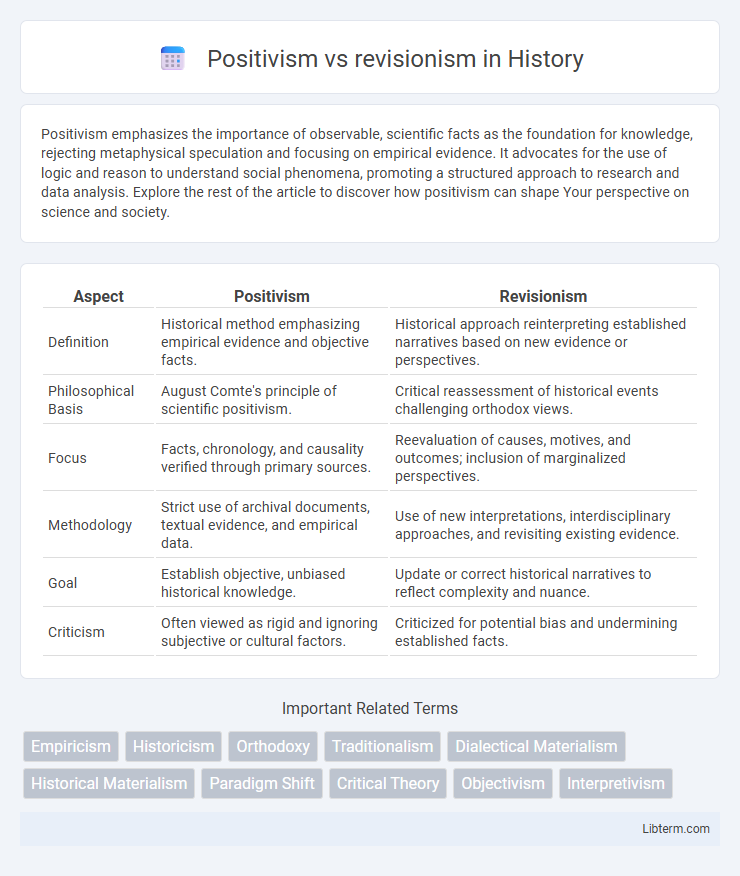Positivism emphasizes the importance of observable, scientific facts as the foundation for knowledge, rejecting metaphysical speculation and focusing on empirical evidence. It advocates for the use of logic and reason to understand social phenomena, promoting a structured approach to research and data analysis. Explore the rest of the article to discover how positivism can shape Your perspective on science and society.
Table of Comparison
| Aspect | Positivism | Revisionism |
|---|---|---|
| Definition | Historical method emphasizing empirical evidence and objective facts. | Historical approach reinterpreting established narratives based on new evidence or perspectives. |
| Philosophical Basis | August Comte's principle of scientific positivism. | Critical reassessment of historical events challenging orthodox views. |
| Focus | Facts, chronology, and causality verified through primary sources. | Reevaluation of causes, motives, and outcomes; inclusion of marginalized perspectives. |
| Methodology | Strict use of archival documents, textual evidence, and empirical data. | Use of new interpretations, interdisciplinary approaches, and revisiting existing evidence. |
| Goal | Establish objective, unbiased historical knowledge. | Update or correct historical narratives to reflect complexity and nuance. |
| Criticism | Often viewed as rigid and ignoring subjective or cultural factors. | Criticized for potential bias and undermining established facts. |
Introduction to Positivism and Revisionism
Positivism emphasizes empirical evidence and scientific method as the foundation of knowledge, advocating for observable facts and data-driven conclusions. Revisionism challenges established historical or ideological narratives, seeking to reinterpret or update them based on new evidence or perspectives. Both frameworks influence social sciences and historical research by shaping how truths and realities are constructed and understood.
Historical Context of the Debate
The debate between positivism and revisionism emerged prominently during the late 19th and early 20th centuries, reflecting contrasting approaches to historical analysis and interpretation. Positivism emphasized empirical evidence, rigorous methods, and the belief in objective historical facts, often associated with historians like Leopold von Ranke. Revisionism challenged this approach by advocating for the inclusion of diverse perspectives, social forces, and the recognition that history is subject to reinterpretation based on new evidence and evolving contexts.
Core Principles of Positivism
Positivism centers on the belief that knowledge should be derived from empirical, observable, and measurable evidence, emphasizing scientific methods and logical reasoning. It rejects metaphysical speculation and prioritizes facts obtained through sensory experience and experimentation. Core principles include the verification of hypotheses through direct observation and the reliance on objective data to establish scientific laws.
Fundamental Tenets of Revisionism
Revisionism challenges the rigid doctrines of Positivism by emphasizing the evolving nature of historical interpretation and the importance of context in understanding social phenomena. Fundamental tenets of Revisionism include critical examination of established narratives, openness to new evidence, and the rejection of absolute objectivity in favor of multiple perspectives. This approach advocates for a dynamic, reflective methodology that adapts theories based on emerging data and diverse viewpoints.
Key Figures in Positivism vs Revisionism
Key figures in Positivism include Auguste Comte, who founded the philosophy emphasizing empirical science and observable facts, and Emile Durkheim, who applied positivist principles to sociology. In contrast, Revisionism features leaders like Eduard Bernstein, who challenged orthodox Marxism by advocating for gradual social reform and democratic processes rather than revolutionary change. These figures represent fundamental ideological divides in political and social theory, shaping debates on progress and societal transformation.
Methodological Differences
Positivism emphasizes empirical observation and scientific methods to generate knowledge, prioritizing measurable data and objectivity in research. Revisionism challenges traditional positivist approaches by incorporating historical context, critical analysis, and interpretative methods to understand social phenomena. These methodological differences highlight positivism's focus on quantifiable evidence versus revisionism's emphasis on conceptual depth and evolving interpretations.
Impact on Historical Interpretation
Positivism in historical interpretation emphasizes empirical evidence and factual accuracy, shaping history as a science based on observable data and objective analysis. Revisionism challenges traditional narratives by reexamining and often questioning established facts, leading to new perspectives and a more nuanced understanding of historical events. Both approaches significantly influence how history is studied and taught, with positivism ensuring rigorous evidence-based conclusions while revisionism encourages critical reassessment and inclusion of diverse viewpoints.
Case Studies Illustrating the Divide
Case studies exemplifying the positivism versus revisionism divide often highlight differing interpretations of historical events, such as the Cold War. Positivist analyses typically emphasize empirical evidence and official documents, asserting a clear, objective narrative grounded in state actions and intentions. Revisionist case studies challenge this perspective by incorporating broader socio-economic factors and questioning established sources, revealing alternative motives and biases in the dominant historical accounts.
Contemporary Relevance and Critiques
Positivism remains influential in contemporary legal systems due to its emphasis on observable laws and objective standards, fostering predictability and stability in governance. Revisionism challenges positivism by highlighting the dynamic and interpretative nature of law, emphasizing context, social values, and moral considerations often neglected by strict legal positivists. Critics argue positivism's rigid framework can overlook justice and equity, while revisionism faces critiques for potentially introducing subjectivity and unpredictability into legal interpretations.
Conclusion: Bridging the Gap
Positivism emphasizes empirical data and observable facts, while revisionism challenges established interpretations by reexamining historical evidence. Bridging the gap between these approaches requires integrating rigorous empirical analysis with critical reinterpretation to foster a more nuanced understanding of social phenomena. This synthesis enhances historiographical accuracy and promotes balanced theoretical frameworks in social sciences.
Positivism Infographic

 libterm.com
libterm.com